This month, we’re a bit top-heavy with news on government activity on hydrogen hubs, transmission, and carbon removal (but we’ll explain why it matters). Also, US automakers make a deal with the UAW, everybody wants to use Tesla’s plugs, carbon tariffs, and more!
Hydrogen Hubs
The Department of Energy announced 7 hydrogen hub projects would receive a total of $7 billion to demonstrate new hydrogen infrastructure.Two different Midwest proposals were selected, including the MachH2 initiative (which involves stakeholders like Constellation, Invenergy, and BP) and also the Heartland Hydrogen Hub in the Minnesota/Dakotas region with Xcel and Marathon Petroleum. Hydrogen is the new bicycle of the energy transition – it can do a lot of different things, and everybody is excited about it, but still faces significant challenges related to price competitiveness and scaling up the supply chain, which some of this funding hopes to address.

Credit: Energy Wire
Spurred by recent legislation, this is demonstration and deployment funding on a much larger scale than has been provided by the federal government in the past, being coordinated out of the new Office of Clean Energy Demonstration. For comparison, this $7 billion announced is almost as large as the entire annual DOE budget for applied energy work (not including the basic science and nuclear cleanup stuff).
Transmission Lines: Long Extension Cords
The Biden administration announced it would commit more than $1 billion to buy capacity on new transmission lines under development, helping address some of the chicken and egg issues with transmission development (until buyers know it’s going to happen, it’s hard to get them to sign up as customers, but without customers signed up it is hard to make the project happen).
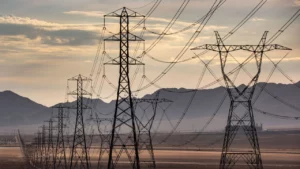
Credit: CNN
Grainbelt Express, a transmission line being developed by Invenergy, received its final state level approval and is tracking towards actually being built (although still in progress).
On the flip side, it appears that some of the same challenges that have killed off transmission lines in the past are creating problems for recently proposed CO2 pipelines as well.
CDR Purchase Prize
The Department of Energy announced a prize to purchase carbon removal from companies, which is essentially the first time the US government has made a commitment to actually buy carbon removal services (vs fund the underlying technology). This is very much an evolving ecosystem, but this adds to the already significant work that large corporate stakeholders like those at Frontier Climate are doing to provide a demand signal for carbon removal.
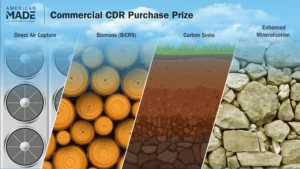
Credit: American Made Challenges, U.S. Department of Energy
Why We Should Care About These Federal Announcements
Although these three federal initiatives target different sectors, and are working to accomplish different goals, at different scales, they are all examples of what a more proactive government approach looks like. Historically, most of the energy transition policy (and the policies of many other sectors, for that matter) have been managed via changes to the tax code in the US – so much so that it probably seems normal to people! However, that is actually a pretty weird way to try to effectuate climate and industrial policy (it’s just one tool in the toolbox). While we still don’t have an actual price mechanism on pollution (like a carbon tax or a cap and trade system), these new investments represent a few more of the levers that the federal government can pull to help enable the transition.
It’s the Sun
LBNL released their annual Tracking the Sun report; it found about 10% of residential solar projects now involve storage as well, including a bunch of retrofits, and that overall system sizes have grown significantly.
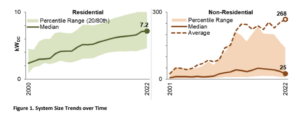
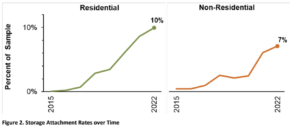
Credit: Tracking the Sun report
NACS Plugs
The sudden realignment to Tesla plugs has continued, with Hyundai, Kia, Chargepoint, BMW, and Toyota jumping on board – so now it’s essentially the remaining holdouts are Volkswagen and Stellantis.
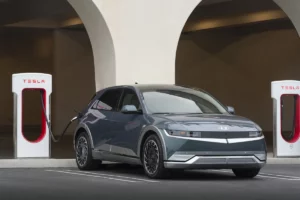
Credit: Hyundai
Labor Deals
The UAW labor strike at GM, Ford, and Stellantis has been resolved – one of the major concessions that was granted was a path to unionizing the companies’ battery plants (which are not entirely owned by the automakers) along with pay increases.
This is a big win for labor, although it will be interesting to see how this plays out over time from a market competition standpoint – the big 3’s EV production costs were already higher than Tesla’s, and this should make them even more lopsided.
Climate quitters
The BBC profiled folks who have recently decided to quit their corporate jobs because of concerns over the direction the companies were headed on climate change. While not everyone may be prepared to quit on the spot for similar reasons, more broadly we are seeing a robust inbound pipeline of individuals who are interested in working in the climate tech space. Many of these folks are shifting sectors (from tech, or energy exploration, or consulting, or elsewhere) for similar moral/priority/global climate imperative reasons. Welcome!

Credit: BBC
Carbon Tariff
A carbon tariff would impose a fee related to carbon emissions on certain imported goods. This is super wonky, but is an extremely interesting neighborhood of climate policy because depending on how it is structured, it could potentially garner bipartisan support. Indeed, Republican Senator Bill Cassidy recently introduced legislation on this very topic. Democrats are interested because they want to penalize and reduce carbon emissions; Republicans are interested because it can serve as a way to support domestic manufacturing (in the GOP proposal imports would only be taxed if their production emissions were at a level higher than the US’s). One unheralded benefit from this sort of legislation is that it would require us to collect much better data about the carbon intensity of different production schemes.
Virtual Power Plant, Actual Loan Guarantee
The DOE issues a $3 billion loan commitment to Sunnova to help finance tens of thousands of residential solar and storage projects. This marks the first approval from the loan guarantee office for a virtual power plant, which is something Jigar Shah (the head of the office) has been outspoken about doing more of. In the past, the projects have been large utility scale energy/power projects; this is a package of distributed projects.
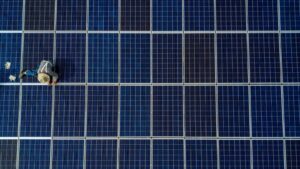
Credit: Utility Dive
Other News
Venture capital fundraising (from limited partners) has fallen off a cliff.
Turns out apparently the Russian oil price caps are not working after all.
Tyson Foods is investing in insect harvesting! Don’t worry, not for you to eat, it’s for animal feed.
The Treasury department issued guidance for how instant rebates for electric vehicles work for dealership
Former Deputy Mayor of Chicago and overall nice guy Samir Mayekar was named to run the University of Chicago’s entrepreneurship center, the Polsky Center.
Cruise had their AV fleet grounded in California after an accident (or more specifically, an accident where they were not as transparent as they could have been about what happened). In happier news, they also announced a wheelchair accessible autonomous vehicle.
Chinese automaker Nio is apparently losing $35,000 per car, although it has also received high marks for recent technological innovation. Perhaps they can make up those losses through larger volumes?